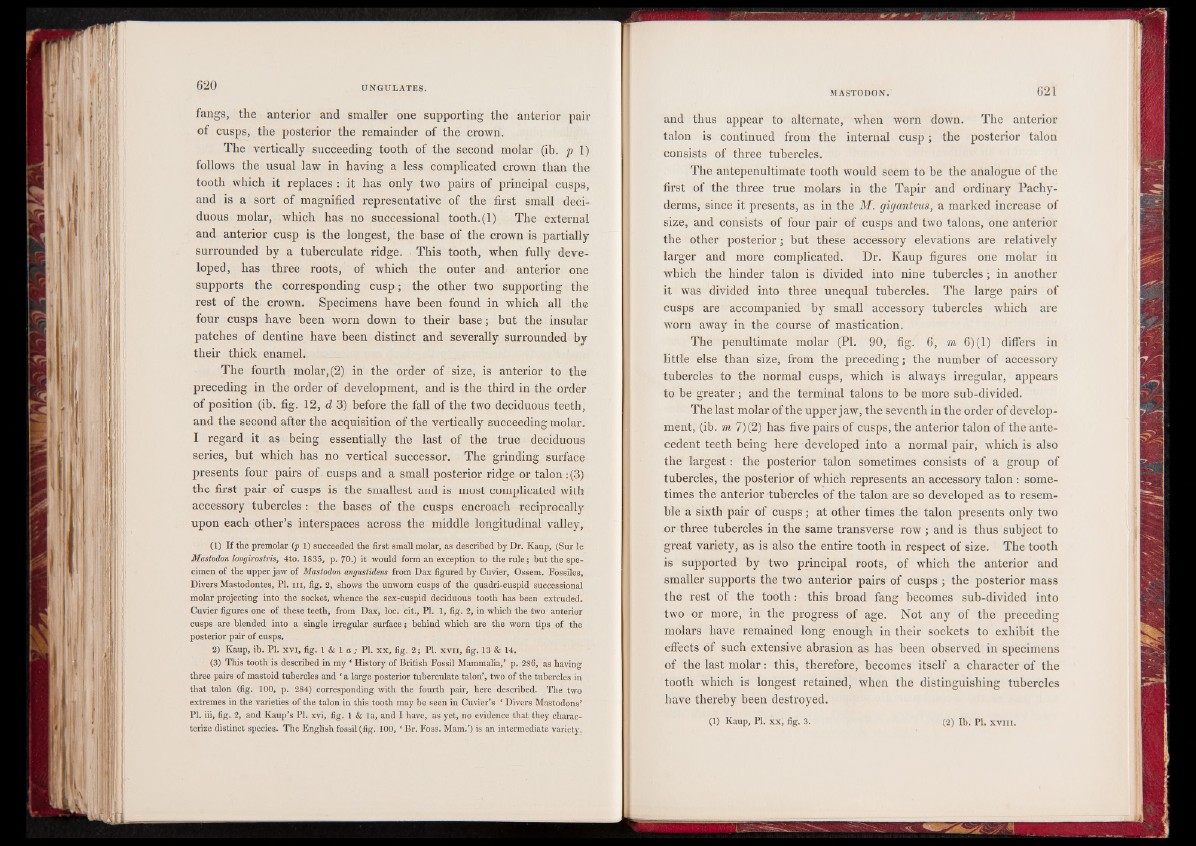
fangs, the anterior and smaller one supporting the anterior pair
of cusps, the posterior the remainder of the crown.
The vertically succeeding tooth of the second molar (ib. P 1)
follows the usual law in having a less complicated crown than the
tooth which it replaces : it has only two pairs of principal cusps,
and is a sort of magnified representative of the first small deciduous
molar, which has no successional tooth. (1) The external
and anterior cusp is the longest, the base of the crown is partially
surrounded by a tuberculate ridge. This tooth, when fully developed,
has three roots, of which the outer and anterior one
supports the corresponding cusp; the other two supporting the
rest of the crown. Specimens have been found in which all the
four cusps have been worn down to their base; but the insular
patches of dentine have been distinct and severally surrounded by
their thick enamel.
The fourth molar, (2) in the order of size, is anterior to the
preceding in the order of development, and is the third in the order
of position (ib. fig. 12, d 3) before the fall of the two deciduous teeth,
and the second after the acquisition of the vertically succeeding molar.
I regard it as being essentially the last of the true deciduous
series, but which has no vertical successor. The grinding surface
presents four pairs of cusps and a small posterior ridge or talon:(3)
the first pair of cusps is the smallest and is most complicated with
accessory tubercles : the bases of the cusps encroach reciprocally
upon each other’s interspaces across the middle longitudinal valley,
(1) If the premolar (p 1) succeeded the first small molar, as described by Dr. Kaup, (Sur le
Mastodon longirostris, 4to. 1835, p. 70.) it would form an exception to the rule; but the specimen
of the upper jaw of Mastodon angustidens from Dax figured by Cuvier, Ossem. Fossiles,
Divers Mastodontes, PI. in, fig. 2, shows the unworn cusps of the quadri-cuspid successional
molar projecting into the socket, whence the sex-cuspid deciduous tooth has been extruded.
Cuvier figures one of these teeth, from Dax, loc. cit., PI. 1, fig. 2, in which the two anterior
cusps are blended into a single irregular surface; behind which are the worn tips of the
posterior pair of cusps.
2) Kaup, ib. PI. xvi, f i g . l & l a ; PI. xx, fig. 2; PI. xvn, fig. 13 & 14.
(3) This tooth is described in my * History of British Fossil Mammalia,’ p. 286, as having
three pairs of mastoid tubercles and ‘ a large posterior tuberculate talon’, two of the tubercles in
that talon (fig. 100, p. 284) corresponding with the fourth pair, here described. The two
extremes in the varieties of the talon in this tooth may be seen in Cuvier’s ‘ Divers Mastodons’
PI. iii, fig. 2, and Kaup’s PI. xvi, fig. 1 & la, and I have, as yet, no evidence that they characterize
distinct species. The English fossil (fig. 100, ' Br. Foss. Mam.’) is an intermediate variety.
and thus appear to alternate, when worn down. The anterior
talon is continued from the internal cusp; the posterior talon
consists of three tubercles.
The antepenultimate tooth would seem to be the analogue of the
first of the three true molars in the Tapir and ordinary Pachyderms,
since it presents, as in the M. giganteus, a marked increase of
size, and consists of four pair of cusps and two talons, one anterior
the other posterior; hut these accessory elevations are relatively
larger and more complicated. Dr. Kaup figures one molar in
which the hinder talon is divided into nine tubercles; in another
it was divided into three unequal tubercles. The large pairs of
cusps are accompanied by small accessory tubercles which are
worn away in the course of mastication.
The penultimate molar (PI. 90, fig. 6, m 6)(1) differs in
little else than size, from the preceding; the number of accessory
tubercles to the normal cusps, which is always irregular, appears
to be greater; and the terminal talons to be more sub-divided.
The last molar of the upper jaw, the seventh in the order of development,
(ib. m 7) (2) has five pairs of cusps, the anterior talon of the antecedent
teeth being here developed into a normal pair, which is also
the largest: the posterior talon sometimes consists of a group of
tubercles, the posterior of which represents an accessory talon : sometimes
the anterior tubercles of the talon are so developed as to resemble
a sixth pair of cusps; at other times the talon presents only two
or three tubercles in the same transverse row ; and is thus subject to
great variety, as is also the entire tooth in respect of size. The tooth
is supported by two principal roots, of which the anterior and
smaller supports the two anterior pairs of cusps ; the posterior mass
the rest of the tooth: this broad fang becomes sub-divided into
two or more, in the progress of age. Not any of the preceding
molars have remained long enough in their sockets to exhibit the
effects of such extensive abrasion as has been observed in specimens
of the last molar: this, therefore, becomes itself a character of the
tooth which is longest retained, when the distinguishing tubercles
have thereby been destroyed.
(1) Kaup, PI. xx, fig. 3. (2) Ib, PI. xvm.